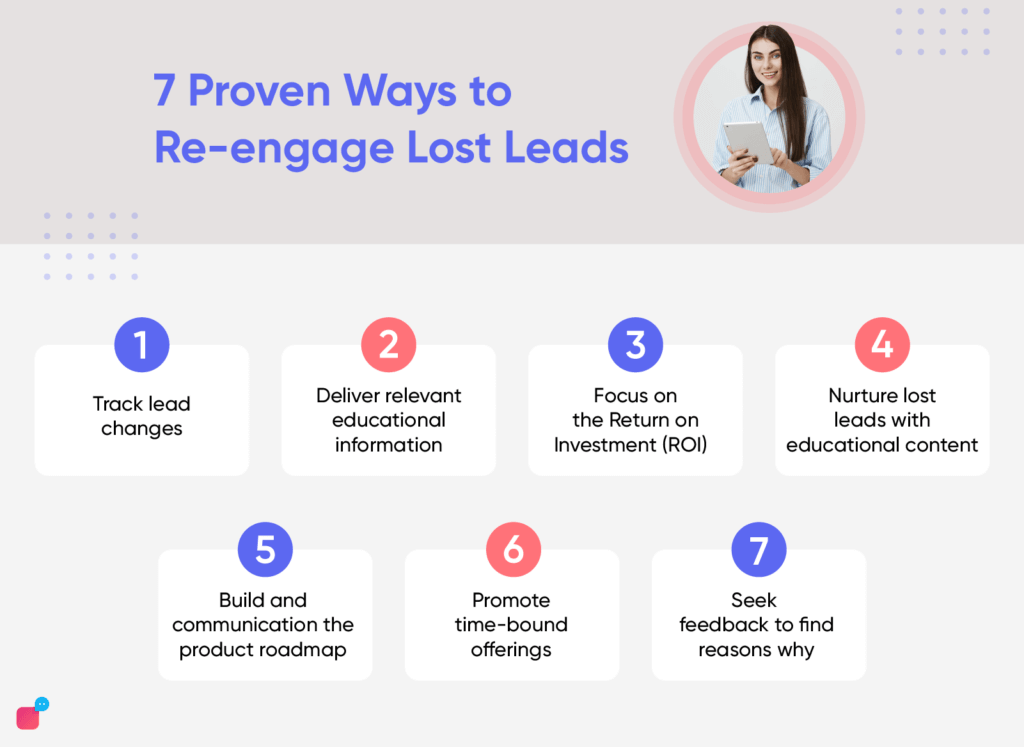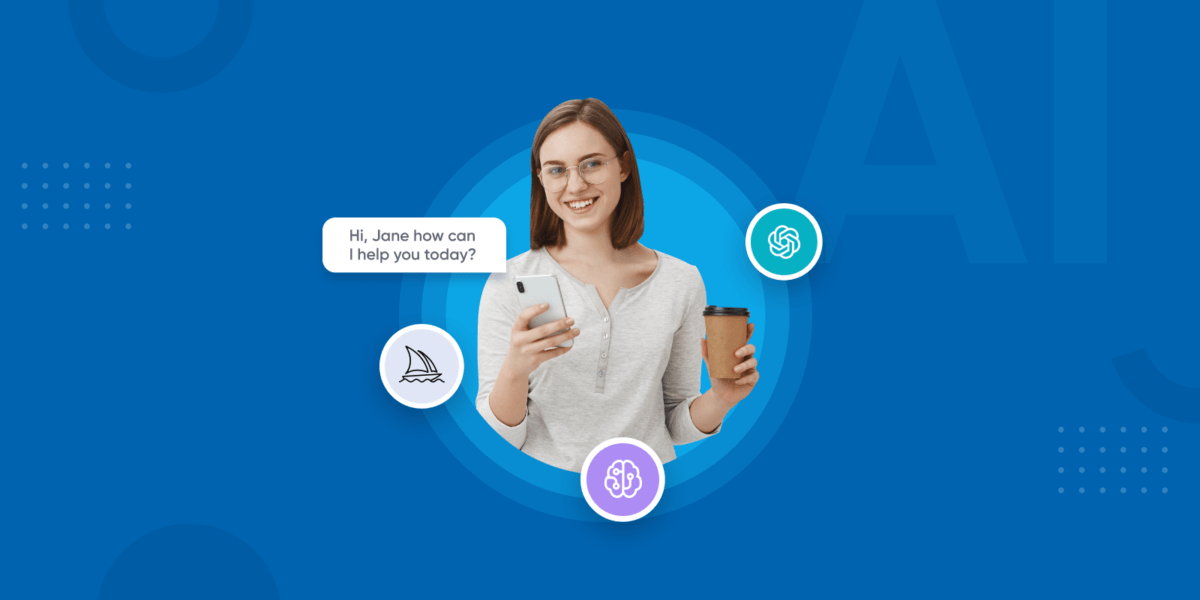
7 Tried and Tested Ways to Re-engage with Lost Leads
- September 5th, 2024 / 8 Mins read
-
Aarti Nair
No matter how efficient you product is, while running a business, you lose leads. Some potential customers may be extremely interested and still turn into ghosts in the pipeline!
However, even a pipeline with lost leads is very useful. Businesses can re-engage with them and turn them into loyal customers. With appropriate tactics, sales teams can reignite the interest among potential clients and offer them products and services.
While running a business for over a decade now, we’ve learned some lessons when it comes to re-engaging with lost leads and converting them into paying customers. In this blog, we’ll ensure you understand the leaks in your sales process and are able to get a solution to re-engage with lost leads.
What is a Dead or Lost Lead?
Industrial Marketer defines it as: A lost/dead lead is a lead that did not convert into a sale and that has been parked in a marketing wasteland. They might remain on a generic email marketing list but they are all too often stranded without any deliberate strategy for re-engaging them.
A lost lead is a potential customer (individual/business) who entered the sales cycle but didn’t go through with it. There can be many possible reasons for this incomplete journey such as change of preferences, lack of information, or even lack of touchpoints!
It is essentially difficult to understand the reason for losing potential customers but we have listed below 7 leak areas where your business might be losing leads.
Possible Reasons for Losing Leads
“The seven sins of the sales process” – are the reasons why you might be losing leads. With personal experience and a lot of research, we’ve listed these sins below:
-
Lack of Awareness
Customers don’t always know everything about your product or the industry and are likely to back out of the sales process if they don’t. To counteract this, you should make it as easy as possible for them to find the information. Unlike an onhand salesman, your website isn’t dynamic when it comes to fielding questions, so preempt the required answers and insert them into your sales media. (Brownie points if you do it outside an FAQ page.)
-
Lack of Budget
Your clients probably backed out because they didn’t have the cash flow to fund the investment into your product. The problem in this instance falls into one of two categories; Either your product is too expensive or their budgets are too small.
-
Loss to a Competitor
Sometimes you lose your customers to a competing company, so the lead goes cold. This could be for a variety of reasons, from bad customer experience to an active poaching attempt, but losses to competitors are some of the most important reference points when you want to improve your lead rejuvenation.
-
People Buy From People
In a world of indistinguishable or similar products like Coke vs. Pepsi, Wendy’s vs. Mcdonald’s or more controversially iOS vs. Android, people and companies tend to buy products from people and companies they like.
Maya Angelou unwittingly summed up company culture beautifully:
“People will forget what you said. People will forget what you did. But people will never forget how you made them feel.”
-
Missing Features
You may have all the features you think your customers need, but if you don’t have what your customer thinks they need, your sales will probably fall through. You may have excluded the feature because no one uses fax machines anymore, but if your clients are American hospitals, you’re losing a lead.
-
Competing Priorities
Decision-makers in companies are flooded with information every day and have a range of priorities with varying degrees of urgency.
Business trends mimic the properties of dry grass; they’re extremely hot, but only for a while.
Your customers may have to put off certain business decisions because of important matters beyond their means, and your sales reps might give up on them because of it.
-
Sales Cracks
The most imperfect part of a machine is often the man who runs it.
Sales representatives have difficult jobs. They’re often burdened by blame, work long hours and handle multiple clients at the same time. It’s no surprise when they occasionally slip up, drop someone off the sales list or lose a lead because of a delayed response.
Having problems isn’t that much of a problem; it’s doing nothing about them even when you know they exist that leaves most companies in the midst of mediocrity.
7 Ways You Can Re-engage Your Lost Leads
Both as a company and an individual contributor, you should take a step back at regular intervals to see how you can plug any leaks, predict any future failures and fix them.
All the seven problems have immediate solutions though, as we’ve listed below:

-
Track Lead Changes
On average companies lose 30% every year of their leads to “decay”. Decay refers to leads that go cold because of changes in contact information, like phone numbers, email addresses or employer information.
With outbound marketing, certain leads you acquired and nurtured may leave their current jobs or move to find better opportunities. This may seem like an impossible sale but it is, in fact, one of the best closing opportunities you may get.
A post-employer-change is when a buyer is the most open to new solutions.
A person who just switched jobs has an empty inbox, so reproaching them establishes a first-mover advantage and cements a sense of loyalty between you and the buyer.
Now, instead of simply having had the lead fall off the map, you’ve created an even stronger relationship between your company and the client. You now have their full attention, and make good use of it.
-
Lead Nurturing Educational Content
In an ideal world, your website replicates your sales representative. It should be never-yielding, always ready and filled with relevant information about your product.
More often than not, this isn’t the case. And on the odd chance, the content is stuffed in a 12-page long FAQ format. Research has shown that information assimilation is the highest when displayed by way of video or live conversation and lowest through plain text.
At this point, we as a team decided to eat our own dog food and trained our Verloop.io bot to answer FAQs and engage with visitors. An FAQ chatbot assimilates all the educational information in one interactive chatbox. Whatever, the question may be, a conversational FAQ chatbot engages the leads with answers to all common queries. This led to a 28% increase in our lead generation.
Leads are lost because the appropriate information wasn’t available at the appropriate time. Create campaigns with Verloop.io’s Outreach feature with personalised, and targeted messaging for your clients. Customer testimonials, call-to-action buttons that link to talking points and competition analysis all help narrow the knowledge gap.
-
Financial Focus, ROI, the Total Cost of Ownership
One of the biggest setbacks to adopting technology comes in the way of cost. Companies want to run state-of-the-art everything, but don’t do so. Leads back out of becoming sales for two reasons; because they either can’t afford it, but more often because they don’t see an equitable return.
To tackle this, focus on the Return on Investment (ROI) that your company provides instead of just the price. Include practical examples of previous clients, or more conceptual pieces that focus on more broad fiscal benefits such as reduced downtime and total cost of ownership (TCO).
If you know your leads’ budget is $500, but your product costs $600, they’re probably going to buy from your cheaper competitor. But if you talk about how your $600 product creates $1800 in sales for them, it’s a more convincing pitch for them to put that extra $100 in.
-
Branded Nurturing
As a sales representative, losing customers to a competitor is one of the most disheartening experiences you’ll have. It’s understandable why after putting so much work into a lead only to have them choose your rival, salespeople consider the lead dead.
But these losses also present themselves as opportunities. Recurring contact with your lost leads can give an industry-analysis-level understanding of your competition. By talking to your leads, you can understand what your competition’s core offerings, pain points, strengths and weaknesses are.
Enrol these leads into a specific nurturing program that talks about your new product offerings, explicit feature differentiators, and special discounts.
-
Product Road Map
A product roadmap communicates direction and progress to internal teams and external stakeholders.
In a ‘feature’ market, it isn’t enough to keep up with the curve, you have to be ahead of it.
A roadmap is simply a management document to ensure an alignment of business goals and product design.
Like us, your product team probably had a good reason to drop certain and include others. Having a roadmap at your disposal can make the difference between a successful pitch and an assumed failure from your client’s perspective.
However, if your customers’ intuition is correct and your product could really use the mentioned feature, it is imperative it gets implemented. If they’re ready to give your product a pass because of it, there’s a very real chance you’ve been losing customers because of it. After implementing these changes, make sure you communicate these updates to your existing customers.
-
Time-bound Promotions
Once you’ve gotten your customer’s attention, you don’t want to let it go. The way to make sure of this is by incentivising them to act as soon as possible.
Time-sensitive promotions are the most commonly used version of this phenomenon, by giving your lead a limited time to take advantage of an offer, you push them to convert them into sales as soon as possible.
These offers can be in the way of discounted pricing, add-on packages, additional customer service benefits or extended warranties. These methods can also be used in email campaigns, to push warm leads into making a purchase, along with re-engagement for lost leads.
-
Survey Trick
The ultimate tool for re-engaging lost or dead leads is a simple mail survey that identifies which of the above problems your customer has run into.
If you’re a company that has under 100 leads, you can maintain a working CRM manually on an excel sheet too.
After you create the list of dead or lost leads, all you need is a trigger for re-engagement. Triggers are a way to reconnect with lost leads, in a manner that is unobtrusive and interesting.
There are two types of triggers, artificial and natural.
Natural triggers include new executives, customer announcements, company expansions, product announcements, new campaigns, successful fiscal quarters/years, awards, additional funding, or press coverage.
Anything that the company is proud of, is an entry strategy for you to slide into their inbox. Drop them a mail, (preferably without a sales pitch so it seems genuine) and congratulate them on their accomplishment. Once they reply, you can use a variation of an artificial trigger to see where they stand.
For an artificial trigger, the plan is fiendishly simple. All you have to do is send them a simple email that holds a mini-survey.
Here’s a sample of the email.
This policy of artificial triggers helps you in three distinct ways.
- You now know the junction at which your customer stands.
- You identify the deficiencies in your sales process/website depending on which options they select.
- You learn how to improve your sales pitch in the future, and based on their response what the strategy is to move forward in the sales cycle.
How Does Conversational AI With Chatbots and Voicebots Help to Re-engage Lost Leads?
An obvious but prevalent reason why you’re losing leads is because of the delay in reaction and the one-size-fits-all approach. Conversational AI, on the other hand, can help you stay at speed through your lead’s decision journey.
If a lead, for example, is spending a considerable amount of time on any of your solution pages, your AI chatbot should be triggered to immediately engage them. It can offer to answer questions (like the FAQ chatbot) or even take a more customised approach based on the leads’ previous chat conversations.
Conversational AI is perceptive enough to collect user data like the lead’s IP address, location, and cookie data to map out the lead’s current intent and stage of the journey. This background data further helps the AI to know what communication will work best for a particular lead.
You can integrate all your third-party tools to ensure to deliver an integrated experience to a lead. Your marketing automation platform and CRM systems offer you deep insights into who exactly a lead is. Not only a chatbot, but your voicebot can re-engage leads with tailor-made information that decimates ambiguity and lack of awareness they have.
I hope this article helped you with your current sales efforts. If you have any questions or want to talk, feel free to hit me up on LinkedIn.
One of the largest and most encompassing reasons companies lose leads is due to a lack of accurate and timely interaction with the client.
Verloop.io automates FAQ, lead capturing, lead qualification, demo scheduling or subscription sign-ups, the always-on bot guides your prospects like they were talking to your best sales representative. Sign up for a demo now if you’re ready to attach a hyperdrive to your marketing and sales efforts.






